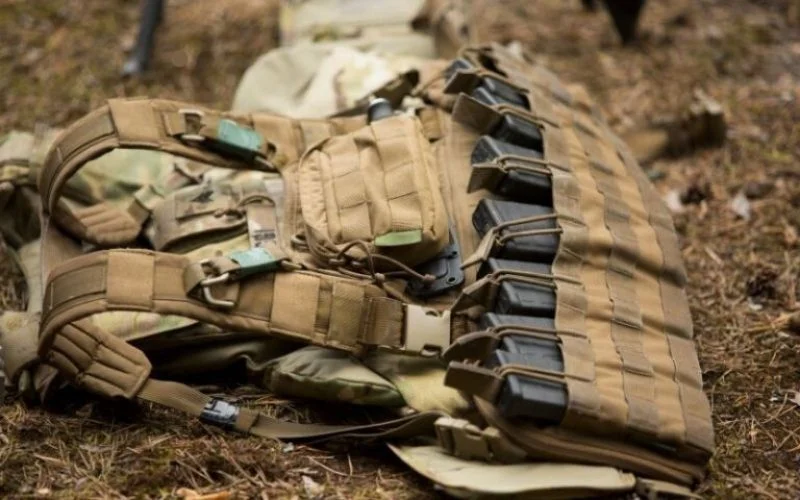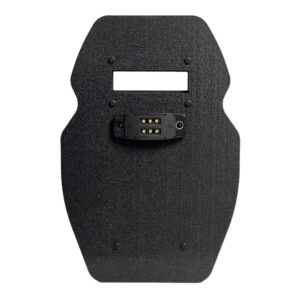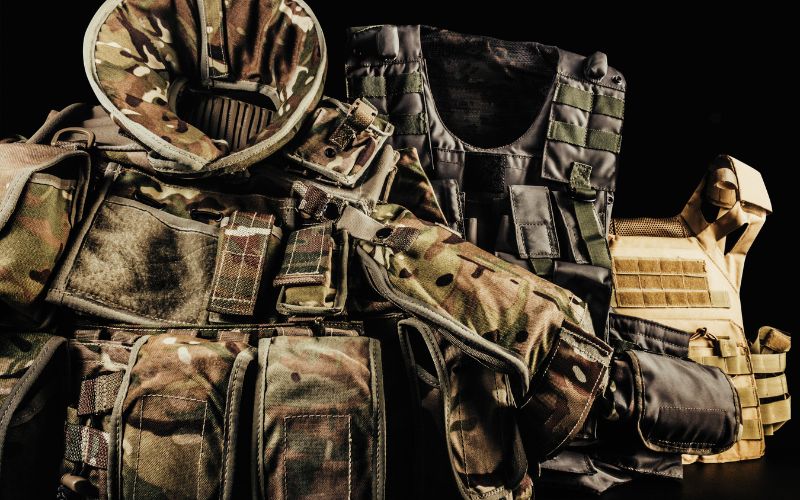The Science Behind Ballistic Protection: How Body Armor Works

Body armor is a critical component of safety protocols for military personnel, law enforcement officers, and even civilians in high-risk environments. Understanding the science behind ballistic protection and how body armor works is essential for appreciating its role in modern security. This ChaseTactical blog delves into the intricate details of these protective systems, exploring the materials, design principles, and underlying science that make them effective.
Body Armor Protection Levels
Body armor is rated by performance standards established by the National Institute of Justice (NIJ). These standards establish different levels of protection according to the types of ammunition that they can neutralize:
Level II protects against 9mm and. .357 Magnum rounds at a moderate velocity. Lightweight and flexible, it is best suited for covert operations.
Level IIIA (IIIA): Provides additional protection, which stops more velocity 9mm and.44 Magnum bullets. Used in law enforcement and city combat operations.
Level III: Hard armor plates that can stop rifle bullets such as 7.62mm. Usually deployed in military and tactical field missions.
The Science Behind Ballistic Protection
The science behind ballistic protection is both fascinating and complex. At its core, ballistic protection aims to prevent or reduce the damage caused by high-velocity projectiles such as bullets and shrapnel. A ballistic helmet, for example, is designed to protect the head from such threats in combat or tactical situations. This involves deeply understanding physics, material science, and engineering principles. By examining how these elements come together, we can better understand how body armor is designed to save lives and reduce injuries.

The Physics Of Ballistic Impact
Ballistic protection relies heavily on understanding the physics of ballistic impact. Like a bullet, a projectile strikes body armor, it transfers kinetic energy. Ballistic protection aims to dissipate this energy to prevent penetration and reduce the impact force on the body. The armor works by spreading the power over a larger area, which diminishes the potential damage. This dispersion is achieved through a combination of material properties and structural design.
Material Science And Ballistic Resistance
Material science plays a pivotal role in ballistic protection. The materials used in body armor are designed to be incredibly strong and lightweight. Common materials include Kevlar, ultra-high-molecular-weight polyethylene (UHMWPE), and ceramics. Kevlar, a type of aramid fiber, is renowned for its high tensile strength-to-weight ratio, making it ideal for absorbing and dispersing energy. UHMWPE, another synthetic polymer, offers similar benefits with added flexibility and lighter weight. Ceramics, often used with these fibers, provide a hard surface that can shatter incoming projectiles, further dispersing the energy.
The Role of Fibers And Weaving Techniques
The arrangement of fibers and the weaving techniques used are crucial in enhancing ballistic protection. Fibers are typically woven into fabrics or stacked in layers to maximize strength and energy absorption. The weave pattern affects how the material responds to impact. For instance, a tight weave can offer more resistance to penetration, while a loose weave may provide better energy dispersion. Advanced weaving techniques, such as those used in ballistic vests and helmets, ensure the fibers work together to create a highly effective barrier.
Ceramic And Composite Armor Systems
Ceramic and composite armor systems are often used with soft body armor to enhance protection against high-velocity projectiles. Ceramics like boron carbide and silicon carbide are extremely hard and can break apart incoming bullets. The underlying layers of material catch these fragments and absorb the remaining energy. Composite armor combines ceramics with fibers like Kevlar or UHMWPE, creating a hybrid system that benefits both materials.

The Importance of Testing And Standards
Rigorous testing and adherence to standards are essential to ensuring the effectiveness of ballistic protection. Organizations such as the National Institute of Justice set stringent guidelines for body armor performance. These NIJ standards involve testing armor against various calibers and types of ammunition to verify its protective capabilities. Regular testing helps maintain high safety standards and ensures that body armor performs as expected in real-world scenarios.
Advances In Ballistic Protection Technology
Technological advancements continue to enhance ballistic protection. Innovations in materials science, such as developing new polymers and nanomaterials, are leading to lighter, stronger, and more flexible armor solutions. Additionally, improvements in manufacturing techniques, like 3D printing, allow for more precise and customizable armor designs. These advancements improve body armor’s effectiveness and increase the wearer’s comfort and mobility.
The Future of Ballistic Protection
The future of ballistic protection looks promising with ongoing research and development. Future body armor systems may incorporate smart materials that adapt to threats or provide real-time data on impact forces and potential breaches. Additionally, advancements in exoskeleton technology could integrate ballistic protection with enhanced physical capabilities, providing comprehensive protection and support for military and law enforcement personnel.
How Body Armor Works

The fundamental principle behind body armor is the effective transfer and dispersion of energy. Body armor plates are constructed from tightly woven strong fibers in a crisscross pattern to form a solid sheet. When a bullet strikes the armor, the energy is spread out and absorbed, significantly reducing the impact force and minimizing blunt force trauma to vital organs. Each layer of the woven material in the armor plate absorbs some of the energy from the projectile, slowing it down and eventually stopping it. The more layers of ballistic material, the greater the protection provided.
Body armor can be broadly categorized into soft and hard armor, each serving different purposes and offering varying levels of protection. This section explores these categories:
Soft Body Armor
Soft body armor is commonly used for protection against lower-velocity threats such as handgun rounds. It is made from woven fibers or layered materials like Kevlar and UHMWPE. The primary function of soft body armor is to absorb and disperse the bullet’s energy, preventing penetration. When a bullet strikes, the fibers absorb the impact energy and deform, spreading the force across a larger area. This reduces the blunt force trauma experienced by the wearer.
Hard Body Armor
Hard body armor, including rifle rounds, is designed to protect against higher-velocity threats. It typically consists of rigid plates from materials like ceramics or metals combined with composite materials. When a high-velocity projectile hits hard body armor, the ceramic layer breaks the bullet into smaller fragments. These fragments are then caught by the underlying composite layers, which absorb and dissipate the remaining energy. Hard body armor is heavier than soft but provides superior protection against high-energy impacts.
Concealed vs. Overt Body Armor
Body armor can be designed for concealed or overt use. Concealed body armor is typically lighter, more flexible, and suitable for covert operations and everyday use by law enforcement officers. Overt body armor is worn over clothing and is often used in high-risk situations where maximum protection is needed. It is more robust and can accommodate protective features like hard armor plates and equipment pouches.
Choosing The Right Armor
There are numerous choices when choosing body armor. Price, level of protection, weight, and coverage are all important factors. You need to think about your particular threat environment. Some users want concealability, while others require maximum ballistic and stab protection. Backpack insert body armor is a discreet option for those prioritizing portability and quick access in everyday scenarios.
For those looking for dependable Level IIIA bulletproof armor, many reliable products find a balance between performance, comfort, and price. Good brands usually show certification that complies with NIJ performance standards, so you receive real-world protection.
Maintenance And Care Of Body Armor
- Inspect soft armor for signs of wear and tear, such as fraying or loss of flexibility.
- Check hard body armor plates for cracks or other damage.
- Keep body armor in a cool and dry place.
- Please keep it away from direct sunlight and chemicals.
- Follow the manufacturer’s instructions for cleaning, which typically involves gentle washing with mild soap and water.
Conclusion
The science behind ballistic protection and the intricate workings of body armor are a testament to the advancements in material science and engineering. Understanding these principles highlights the effectiveness of these protective systems and underscores their importance in safeguarding lives. As technology continues to evolve, the future of ballistic protection promises even more sophisticated and reliable solutions, ensuring that those who put themselves in harm’s way have the best possible defense.
Frequently Asked Questions
What is the difference between Level II and Level IIIA armor?
Level II armor stops lower-velocity handgun rounds, such as 9mm, whereas Level IIIA is more resistant and stops 9mm and 44 Magnum rounds at higher velocities.
Can body armor stop stab threats as well as bullets?
Certain armor provides double protection, but basic ballistic panels often do not deflect knives or sharp blades. If necessary, consider armor with supplementary stab protection.
When do I need to replace my body armor?
Inspect the label for an expiration date. Soft body armor usually has a lifespan of 5 years. Also, check for obvious damage or wear, particularly after a blow or extended field use.
